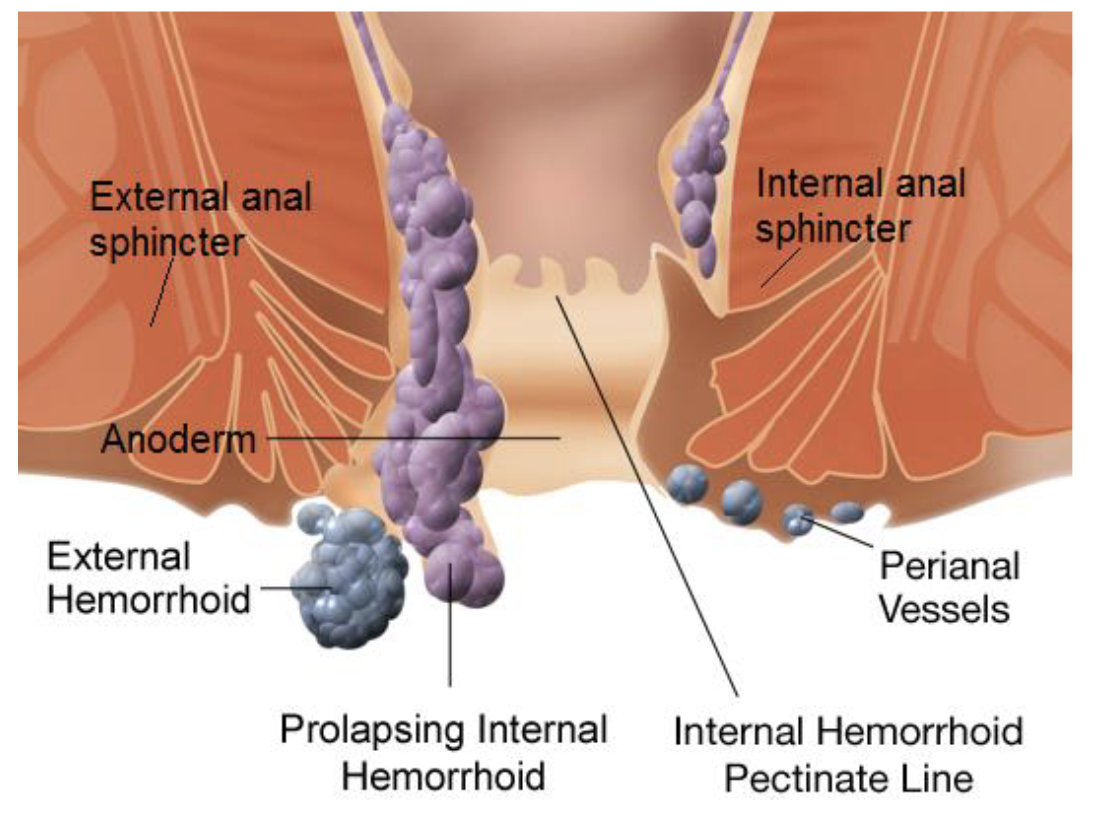Hemorrhoids
What are hemorrhoids?
Hemorrhoids are swollen veins in the anus and low rectum. Hemorrhoids, also called piles, are similar to varicose veins. Hemorrhoids are the most frequent anorectal disease. Hemorrhoids occur in 5% - 40% of the population. Constipation and straining to have a bowel movement can make hemorrhoids worse.

By WikipedianProlific and Mikael Häggström - File: Hemorrhoid.png by WikipedianProlific, CC BY-SA 3.0, commons.wikimedia.org/w/index.php
Types of hemorrhoids
Internal hemorrhoids
Internal hemorrhoids are located inside the rectum. They are often painless but tend to bleed.
External hemorrhoids
External hemorrhoids are located outside the rectum. They can cause pain if irritated or plugged by a blood clot (thrombosed).
What are the symptoms of hemorrhoids?
- Bleeding is the most common symptom of hemorrhoids.
- Internal hemorrhoids can fall through the anus and become traumatized. This can lead to bright red bleeding from the anus.
- Anal itching and skin irritation can occur with internal hemorrhoids.
- Leakage of stool can occur when hemorrhoids fall through the anal canal and prevent proper sealing of the canal.
- Painful swelling near the anus can occur when external hemorrhoids become inflamed or plugged by a blood clot (thrombosed).
How are hemorrhoids diagnosed?
Hemorrhoids are diagnosed with a medical history and physical examination. Your medical provider may inspect the area around the anus to check for any abnormal areas and a digital rectal examination may be performed.
- Endoscopy: Tests that look inside the colon (large intestine)
- Anoscopy: An anal speculum (anoscope) is placed in the anus to look at the lower rectum
- Flexible Sigmoidoscopy: A flexible camera is used to look at the colon from the sigmoid to the rectum (distal colon)
- Colonoscopy: A flexible camera is used to look at the entire colon
What are the treatment options for hemorrhoids?
There are several treatment options for hemorrhoids. Treatment may depend on how serious symptoms are.
Treatments options include:
- Dietary and lifestyle changes
- Medication
- Non-surgical minimally invasive treatments
- Rubber band ligation
- Radiofrequency ablation
- Infrared photocoagulation
- Sclerosis injection
- Surgery
- Doppler-guided hemorrhoidal
- Ligation
- Alternative non-surgical treatment
- Embolization of the superior rectal
- Arteris
Superior rectal artery embolization
An Interventional Radiologist performs this minimally invasive procedure for grade one through three internal hemorrhoids. The procedure takes place in an outpatient setting in our Interventional Radiology suite. This is in an office setting and does not require hospitalization. Embolization is performed with local anesthesia and sedation (“twilight sleep”).
Internal hemorrhoids are composed of a dense artery and vein network called Corpus Cavernosum Recti (CCR). Embolization of the hemorrhoidal artery reduces blood flow in the CCR. This decreases pressure in the veins and improves symptoms.
The procedure is performed through a tiny cut in the wrist or the groin. A thin tube called a microcatheter is inserted into the rectal artery under x-ray. The catheter is guided through the superior rectal artery tree to the last branches. The Interventional Radiologist uses a moving x-ray called a fluoroscope to guide the procedure. Small coils and/or microspheres are placed into the last branches of the arteries to seal or “embolize” the vessels.
It may be necessary to repeat the embolization for hemorrhoids on the opposite side. Often the same entry point and the same microcatheter can be used.
Dr. Piechowiak discusses Hemorrhoid Embolization
Recovery
Hemorrhoidal artery embolization causes minimal pain. The procedure is approximately 45 minutes. Recovery is usually two hours. Patients can return home on the same day. People can often return to work the day after the procedure.
Advantages of superior rectal artery embolization
- No general anaesthesia needed
- Preserves anal continence - avoids stool leakage
- Does not create painful rectal wounds
- Leaves hemorrhoidal tissue in place
- Good short-term results
Contact us to request an appointment or ask a question. We're here for you.



